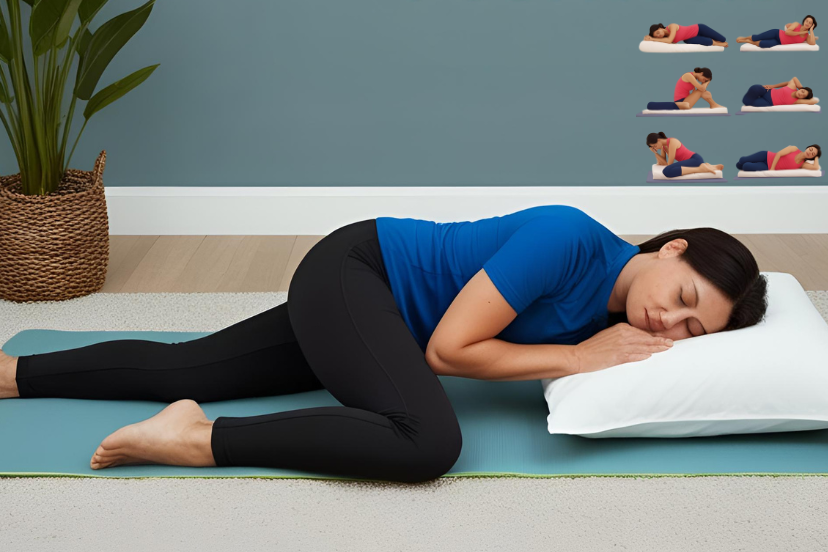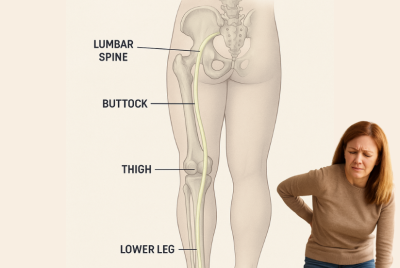How to Sleep Better with Sciatica: 5 Pain-Free Sleeping Positions
Sciatica pain can be frustrating during the day, but at night, it can feel relentless. Tossing and turning, numbness, or sharp pain down your leg can keep you from getting the rest your body needs to heal. So, how do you actually sleep better with sciatica?
In this guide, we’ll explore:
-
Why sciatica gets worse at night
-
The best sleeping positions for sciatica
-
Pillow placements that ease pressure
-
Ideal mattress and bedding options
-
Gentle stretches to relax your body before bed
🌙 The Sciatica-Sleep Connection
Sciatica is caused by irritation or compression of the sciatic nerve, which runs from the lower spine down the back of each leg. At night, sciatica symptoms often feel worse due to several factors:
-
Lying flat can increase pressure on the lumbar discs or joints.
-
Inflammation may build up after a full day of activity or poor posture.
-
Your mattress or pillow may fail to support proper spinal alignment.
The result? Difficulty falling or staying asleep—and waking up feeling stiff, sore, and fatigued.
😴 5 Best Sleeping Positions for Sciatica Pain Relief
Sleeping posture can dramatically influence how much pain you feel at night. Below are the top 5 positions recommended by physical therapists and spine specialists.
1. Side Sleeping with a Pillow Between Knees
This is one of the most recommended positions for sciatica.
How to do it:
-
Lie on your non-painful side (usually opposite the sciatic pain).
-
Place a firm pillow between your knees.
-
Keep your knees slightly bent and your hips aligned.
Why it works: This position reduces lower back rotation, keeps the spine neutral, and relieves pressure on the sciatic nerve.
2. Fetal Position
Curling into a loose fetal position opens the space between vertebrae in the spine.
How to do it:
-
Lie on your side and gently curl your knees toward your chest.
-
Place a pillow between your knees for added support.
-
Keep your neck aligned with a supportive pillow.
Tip: This is especially helpful if your sciatica is caused by a herniated disc, as it widens the spaces between your spine.
3. Sleeping on Your Back with Knees Elevated
Back sleeping can be tricky for sciatica, but elevating the knees changes everything.
How to do it:
-
Lie flat on your back.
-
Place a couple of pillows or a wedge under your knees so they remain slightly bent.
-
Keep your arms by your sides or across your belly.
Why it works: Elevating the knees reduces tension in the lower back and pelvis, easing pressure on the sciatic nerve.
4. Sleeping in a Reclined Position
Sleeping in a reclined chair or adjustable bed can relieve sciatica in some cases, especially if spinal compression is the issue.
How to do it:
-
Use a recliner or adjustable base to elevate your upper body and legs.
-
Aim for a gentle “V” shape in your body to take pressure off the spine.
Best for: People with isthmic spondylolisthesis or disc herniation.
5. Sleeping with a Body Pillow
Body pillows are great for full-body support and spinal alignment.
How to do it:
-
Lie on your side and hug a full-length body pillow.
-
Place part of the pillow between your knees and under your arm.
-
Keep your spine straight and avoid twisting.
Bonus: Helps prevent rolling into painful positions during the night.
How to Sleep Better with Sciatica Pain
🛏️ Pillow Placements That Help with Sciatica
Pillows are your best friends when it comes to spinal alignment and nerve decompression at night. Here are a few smart placements:
-
✅ Between the knees – Keeps hips aligned when side-sleeping.
-
✅ Under the knees – Supports the lumbar spine in back sleepers.
-
✅ Under lower back – Adds lumbar support if the mattress is too soft.
-
✅ Between thighs and ankles – Reduces hip rotation in side sleepers.
🧠 Tip: Use firm pillows or memory foam. Soft pillows may collapse overnight and lose effectiveness.
🛏️ Best Mattress and Bedding for Sciatica Relief
Your mattress can either support healing or make pain worse. Look for one that offers the right balance of comfort and spinal support.
✔️ Mattress Tips:
-
Medium-firm mattresses are generally best for sciatica.
-
Consider hybrid mattresses (memory foam + innerspring) for pressure relief and support.
-
If your mattress is too soft, use a firm mattress topper to improve alignment.
💤 Bedding Upgrades:
-
Use a contoured memory foam pillow for neck alignment.
-
Opt for breathable sheets and blankets to reduce tossing and turning from heat.
-
Try a wedge pillow under your knees or back to maintain position.
🧘♀️ Evening Stretches for Bedtime Sciatica Relief
A few gentle stretches before bed can loosen tight muscles, improve circulation, and reduce nerve irritation.
1. Knee-to-Chest Stretch
-
Lie on your back, bring one knee to your chest.
-
Hold for 20–30 seconds, switch sides.
-
Helps release tension in the lower back and glutes.
2. Piriformis Stretch (Seated or Supine)
-
Cross one ankle over the opposite knee.
-
Gently pull the supporting leg toward your chest.
-
Relieves tension in the piriformis, which often presses on the sciatic nerve.
3. Child’s Pose
-
Kneel, lower your torso between your thighs, arms extended forward.
-
Relieves tension in the spine and hips.
4. Cat-Cow Stretch
-
On hands and knees, alternate arching and rounding your back.
-
Promotes spinal mobility and relieves nerve pressure.
🌙 Do these stretches 15–30 minutes before bed for best results.
✅ Sciatica Sleep Survival Checklist
Before bed, make sure to:
-
🛏 Sleep on a supportive mattress
-
🌙 Choose a pain-relieving position (side or reclined)
-
🧘♀️ Stretch to relax muscles and reduce inflammation
-
💤 Use pillows for support and alignment
-
🔁 Change positions if discomfort arises
✅ 5 FAQs for How to Sleep Better with Sciatica Pain
1. What is the best sleeping position for sciatica pain?
The best position is sleeping on your side with a pillow between your knees or on your back with your knees elevated. Both help keep your spine aligned and reduce pressure on the sciatic nerve.
2. Can a bad mattress cause sciatica to worsen at night?
Yes, a mattress that’s too soft or lacks support can cause poor spinal alignment, increasing sciatic nerve irritation. A medium-firm mattress is typically recommended.
3. Is it okay to sleep on your stomach with sciatica?
No, sleeping on your stomach can strain your lower back and twist your spine, which may aggravate sciatic pain.
4. Do pillows help relieve sciatica pain while sleeping?
Absolutely. Placing pillows between the knees, under the knees, or under the lower back helps maintain proper posture and relieve nerve pressure.
5. What can I do before bed to reduce sciatica pain?
Gentle stretching, a warm shower, using a firm mattress, and maintaining good sleep posture can all help reduce sciatica pain at night.
🧠 Final Thoughts: You Can Sleep with Sciatica
Sciatica doesn’t have to ruin your nights. With the right sleep position, mattress, and bedtime routine, you can reduce pain, wake up more refreshed, and give your body the rest it needs to heal.
Experiment with these positions, and listen to your body. Often, a small change in how you sleep leads to big pain relief.
Disclaimer
Please note that this article should not replace professional medical advice. Consult a healthcare professional for an accurate diagnosis and tailored treatment plan.
👉 Next Reads:





